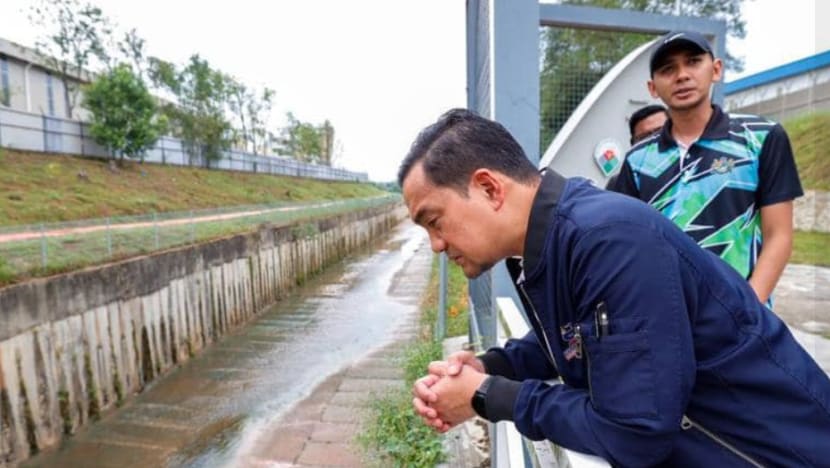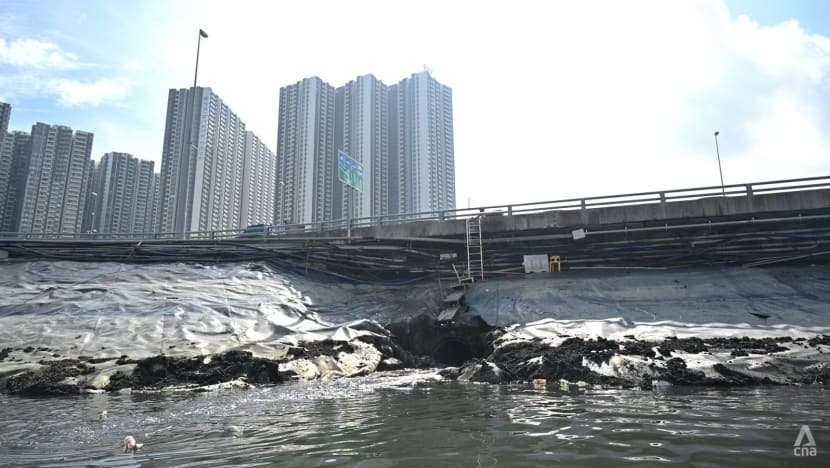Johor Strait fishermen bemoan poorer hauls; experts say reclamation and Causeway design could be factors
Observers say that reclamation and the structure of one of the world’s busiest land border crossings restrict water flow on the Johor Strait and traps pollutants, impacting the marine ecosystem.

Trash accumulates at waters near the Causeway. (Photo: CNA/Zamzahuri Abas)

This audio is generated by an AI tool.
JOHOR BAHRU: Within 10 minutes of casting his net into the Johor Strait, fisherman Jefree Salim knew instinctively that the day’s trip would not yield much catch.
The waters are around 20m from the Johor-Singapore Causeway, a road and rail link between the Republic and Johor Bahru in Malaysia and one of the busiest land border crossings in the world, ferrying more than 300,000 people daily across the border.
“Can you smell that stench? And the colour of the water is not good,” said 42-year-old Mr Jefree who is part of the indigenous Orang Seletar community who have fished along the Straits of Johor for generations.
As he dragged up the nets from the grey-murky water, a suffocating odour wafted through the air.
Mr Jefree then turned his boat around 100m away from the Causeway towards another “familiar spot” near the buoy marking the international maritime border between Malaysia and Singapore, before throwing his line down into the deep waters.

An hour later, neither Mr Jefree nor the two other fishing boats in the vicinity had caught any fish.
“This is usual for fishing in this area,” said Mr Jefree, who relies on seafood catch as a portion of his income to support his wife and two daughters.
“Over the last 20 to 30 years, the pollution has become much worse, and the catch has reduced by a lot,” he added.
Like in many coastal communities around the world, the Johor Strait has not been spared the effects of climate change and pollution.
Yet, experts and observers CNA spoke to said that the issue has been exacerbated by the Causeway’s structure - a large embankment - which restricts water flowing through it.
This has in turn impacted marine life growth and decreased the seafood catch for fishermen, they added.

At the same time, both the governments of Singapore and Malaysia have made efforts to minimise the ecological impact on the Johor Strait.
The Singapore government has conducted environmental studies in areas where development works are being slated for to ensure that marine life is not adversely affected.
Meanwhile, the Johor state government has launched several river clean-up initiatives to work with residents as well as firms to ensure that trash and industrial waste are not improperly disposed into tributaries leading to the strait.
Conservation scientist Serina Rahman, who is a lecturer with the National University of Singapore’s Southeast Asian Studies department, gave a presentation on the subject during a seminar in May in conjunction with the Causeway Centennial.
The associate fellow with ISEAS-Yusof Ishak Institute also highlighted how the Causeway, unlike the Tuas Second Link - which is a bridge between the two countries set on concrete pillars - halts water flow from one side of the Johor Strait to the other.
Dr Serina said this is evident in how the waters on each side of the Causeway may sometimes have different colours or levels, due to uneven water table creating “different tidal compartments”.
A water table refers to the upper level of an underground surface in which the soil or rocks are permanently saturated with water.

In an interview with CNA, Dr Serina stressed that the trapping of pollutants and debris can lead to “severe” ecological, and subsequently health and economic implications.
“As long as there's water flow, things that come into the strait from land on both sides are able to move. As (pollutants) move, it sort of dissolves and disintegrates, reducing its impact,” said Dr Serina.
“But when it’s allowed to accumulate, that’s when we see exacerbated problems. You can’t just flush away the damaging substances.
“On both sides of the bridge, there’s aquaculture … So when pollutants accumulate, they affect the fish being bred, which then impacts the quality of the seafood,” she added.
THREATENED LEGACIES
The issue of polluted water in the Johor Strait is not a new phenomenon.
Studies published by Universiti Teknologi Malaysia and Universiti Putra Malaysia in 2019 and 2013 respectively said that samples of water in the strait contained heavy metal and microplastics pollution.
Pollution at the tributaries leading to the Johor Strait has also been widely commented on by authorities.
In 2019, Singapore’s then-Prime Minister Lee Hsien Loong raised concerns about pollution and the long-term yield of the Johor River, a major channel located around 30km from the Causeway.
Under the 1962 Water Agreement between Singapore and Malaysia, Singapore can buy 250 million gallons of water a day from the Johor River, at 3 Malaysian sen for every 1,000 gallons.
In 2021, Johor ruler Sultan Ibrahim Iskandar also criticised some residents for disposing of their waste into the drainage network, which includes rivers and ditches flowing into the Tebrau Strait.

Between 2022 and 2023, Johor Chief Minister Onn Hafiz Ghazi spearheaded the “clean our rivers” initiative in Johor - a programme to clear debris from the state’s rivers and educate the public on the importance of not disposing of their rubbish indiscriminately.
However, Orang Seletar mussel fisherman Atik, who goes by only one name, told CNA that he believes that the pollution issue has only gotten worse recently, evident by the depleting yield of green mussels.
The fishing community at the Johor Strait also collect the molluscs which are sold to local markets and seafood restaurants in Johor Bahru.
“In recent years, the mussel breeding season has been confined to only once a year. Five years ago, we could breed mussels twice, and our output has been halved … recently even less,” he added.
Mr Atik added that he endeavours to collect at least 2kg of mussels during each fishing trip because if his catch is any less, the profit would not cover the petrol costs for his boat. He says that these days, for every 10 trips he goes out to sea, three would not yield sufficient catch to cover his expenses.

He expressed concern that the Orang Seletar may no longer fish for a living if the catch continues to deplete to a point where it is not sustainable.
“I hope my children will be able to continue … the legacy of our forefathers to fish in these waters for a living. But … it may not be possible,” he added.
CULVERTS COULD EASE POLLUTION
Observers CNA spoke to have suggested structural developments to the Causeway to enable water to flow through better and alleviate the pollution problem.

Tunnelling expert and Causeway enthusiast Tja Kim Huat, 59, who founded the Facebook group Eco-Link@Causeway to raise awareness about ecological problems in the Johor Strait, told CNA that he believes the authorities should repair and add more culverts to the bottom part of the motorway.
Culverts are pipe structures that allow water to flow through the Causeway.
According to blueprints seen by CNA, culverts were in the original design of the Causeway but most have been shut over the years following construction works.

When the Causeway was opened in 1924, it had a lock channel and lifting bridge on the Johor side to allow small vessels to pass through. It also had 10 culverts.
The lifting bridge and lock channel were destroyed during WWII by British troops who bombed the Causeway to prevent Japanese troops from advancing.
When CNA followed Mr Jefree for his fishing trip in waters near the Malaysia side of the Causeway in July, only one culvert was visible and the opening was clogged with rubbish.

The Orang Seletar fisherman told CNA: “I hope they can repair these pipes and perhaps even reintroduce the (lifting bridge). It would be nice to finally drive boats across the Causeway … like how our forefathers once did (before WWII).”
Dr Serina echoed similar sentiments, saying that the repair of culverts could improve marine conditions, such as water cleanliness and ecological environments.
However, she suggested that in tandem, both Singapore and Malaysia should also ensure that reclamation works do not impact the marine conditions in the Johor Strait.
On the Johor side, land along Danga Bay and Lido Beach is being reclaimed for a number of development projects, including residential and commercial purposes.
Meanwhile on the Singapore side, industrial developer JTC Corporation and the Immigration and Checkpoints Authority (ICA) have announced reclamation works planned for the Woodlands area to expand the border checkpoint there.
The redevelopment of the border checkpoint is set to start in 2025 and will be completed across several phases over the next 10 to 15 years.
Once fully redeveloped, the new checkpoint will be about five times the current size and aims to cut the average clearance time from one hour to 15 minutes during peak periods.
Following an environmental impact assessment (EIA) done ahead of the planned reclamation, JTC Corporation and ICA stressed that the works are unlikely to have a negative impact on the mangrove habitats in the neighbouring Mandai Mangrove and Mudflat.

In a statement in August 2023 on the EIA report, ICA stressed that the project is predicted to have “no significant impact” in terms of surface hydrology and water quality as well as biodiversity and ecology.
It cited that “notable predicted impacts” included “limited loss of terrestrial habitats, flora and ecological connectivity”.
“Given the spatially limited extent of habitat loss and fragmentation, and the proposed mitigation measures which include the establishment of green buffers, enhancement plantings with native flora species, and incorporation of vertical greenery, the residual impact significance is reduced,” ICA said then.
“Predicted impacts arising from this project to human receptors are generally of low concern,” it added.
Environmental enthusiast Wayne Wong, a Singaporean who previously worked with companies involved in marine infrastructural development in the region, told CNA that aside from such reports, he hopes that both the Singapore and Malaysia government would work together with environmental groups to monitor the situation in the Johor Strait.

Mr Wong cited for example how harmful algal bloom in the Johor Strait could be prevented if environmentalist groups are able to give feedback directly to authorities. These incidents typically lead to mass fish deaths and impact fishermen from both Singapore and Malaysia.
According to a 2021 review paper published by Singapore researchers, there were 22 reported events of harmful algal bloom between 1987 and 2017 and most of them occurred in the Johor Strait.
“Such ‘ground-up’ initiatives are more effective … and more sustainable in the medium, longer term,” said Mr Wong.
“Environmental observers can provide check and balance and give early advance warning to (the) respective authorities,” he added.
Meanwhile, Causeway enthusiast Mr Tja expressed hope that with more cooperation between the two governments, there will be a time where he can see fishermen earning a living on the waters again.
“I got the chance to see the waterway when I was a kid. I was young at that time. I saw a lot of fishermen at the Causeway. Nowadays you don’t see fishermen,” he said.
















